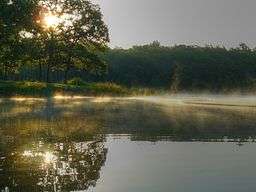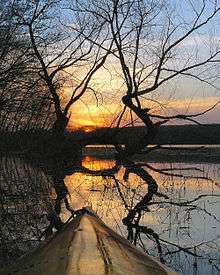Okmulgee State Park
| Okmulgee State Park | |
| Oklahoma State Park | |
 Sunrise over Okmulgee Lake | |
| named for: Okmulgee, Oklahoma | |
| Country | United States |
|---|---|
| State | Oklahoma |
| County | Okmulgee County |
| Elevation | 758 ft (231 m) [1] |
| Coordinates | 35°36′01″N 96°03′35″W / 35.60028°N 96.05972°WCoordinates: 35°36′01″N 96°03′35″W / 35.60028°N 96.05972°W |
| Area | 1,075 acres (435 ha) |
| Established | 1963 |
| Management | Oklahoma Tourism and Recreation Department |
|
Location of Okmulgee State Park in Oklahoma
| |
| Website: Okmulgee State Park | |

Okmulgee State Park is an Oklahoma state park in Okmulgee County, Oklahoma in the United States. The park is 1,075 acres (435 ha) and sits at an elevation of 758 feet (231 m).[1] The park is adjacent to Dripping Springs State Park and is located on Okmulgee Lake. Okmulgee State Park, established in 1963, is open for year-round recreation including camping, fishing, swimming and hiking.[2]
History
Okmulgee State Park is on land that was at the bottom of a vast inland sea 200 to 350 million years ago. The rocks at the park date back to the Pennsylvanian Period. Okmulgee and neighboring Dripping Springs State Parks are two of the very few places in the world where the rare fossil, Gymnophyllum wardi also known as "button coral", can be found.[3][4]
The Muscogee Indians were forced from their homes in Alabama, Florida and Georgia in the 1830s. They relocated in what was then known as Indian Territory under the authority of President Andrew Jackson and settled on a spring which they named, Okmulgee, meaning bubbling or boiling water.[3][5] When Jackson was elected president in 1829 the government stance toward Indians changed.[6] Jackson abandoned the policy of his predecessors of treating different Indian groups as separate nations.[6] Instead, he aggressively pursued plans to move all Indian tribes living east of the Mississippi River to what is now Oklahoma.[6]
At Jackson's request, the United States Congress opened a debate on an Indian Removal Bill.[6] In the end, the bill passed, but the vote was close. The Senate passed the measure 28 to 19, while in the House it passed by, 102 to 97. Jackson signed the legislation into law June 30, 1830.[6]
Following the Indian Removal Act, in 1832 the Creek National Council signed the Treaty of Cusseta, ceding their remaining lands east of the Mississippi to the U.S., and accepting relocation to the Indian Territory. Most Muscogee were removed to Indian Territory during the Trail of Tears in 1834, although some remained behind. The Muscogee that settled in Oklahoma live near what is now Okmulgee State Park.[3] They consider the nearby city of Okmulgee to be their capital."[5]
The facilities of Okmulgee and Dripping Springs State Parks were constructed by the Works Progress Administration and Civilian Conservation Corps.[3] The WPA and CCC were work relief programs for men from unemployed families, established during the Great Depression. As part of President Franklin D. Roosevelt's New Deal legislation, they were designed to combat unemployment during the Great Depression. The WPA and CCC operated in every U.S. state.[7] The men of the WPA and CCC replaced an earthen dam at Okmulgee Lake which was built in 1927. They also built a spillway and many of the park facilities that are still in use today.[3]
Okmulgee State Park became an Oklahoma state park when management of the park was transferred from the city of Okmulgee to the state in 1963. The park expanded in 1988 when Dripping Springs Lake was leased to the state by the city.[3]
Recreation
Okmulgee State Park is open for year-round recreation. Okmulgee Lake is open to fishing, boating and swimming. The lake which was built in 1926 to provide water for the city of Okmulgee is considered to be an "old fishing lake."[8] The lake bottom features large boulders and thick oak tree trunks. Common game fish found in the lake are crappie, white bass, sunfish, largemouth bass, and channel catfish.[8] Okmulgee Lake has been designated as an Oklahoma "Trophy Bass Lake."[3] In addition to fishing the lake is open to boating, kayaking, swimming, and water-skiing.[2] There are 75 RV camping sites and 50 tent camping sites at the park. The boat ramps are lit. Okmulgee State Park also features a 3-mile (4.8 km) hiking trail and extensive picnic facilities.[2] Hunting is not permitted within the park, but a public hunting area is located on the north and west side of the lake.[3]
References
- 1 2 "Okmulgee State Park". Geographic Names Information System. United States Geological Survey. September 9, 1997. Retrieved September 24, 2010.
- 1 2 3 "Okmulgee State Park". Oklahoma Tourism and Recreation Department. Retrieved September 25, 2010.
- 1 2 3 4 5 6 7 8 "More History on Okmulgee/Dripping Springs State Park". Shop Oklahoma. Retrieved September 25, 2010.
- ↑ Sutherland, P. K.; Haugh, B. N. (1969). "The Discoid Rugose Coral Gymnophyllum: Growth Form and Morphology". In Campbell, K. S. W. Stratigraphy and paleontology; essays in honour of Dorothy Hill. Australian National University Press. pp. 27–49.
- 1 2 Oklahoma Almanac pp. 468-469. Accessed January 15, 2007.
- 1 2 3 4 5 Sharyn Kane & Richard Keeton. "Fort Benning – The Land and the People". SEAC. Retrieved September 25, 2010.
|chapter=ignored (help) - ↑ Paige, John C. (1985). "Chapter One: A Brief History of the Civilian Conservation Corps". The Civilian Conservation Corps and the National Park Service, 1933-1942: An Administrative History. Washington, D.C.: U.S. National Park Service, Department of the Interior. OCLC 12072830. Retrieved September 25, 2010.
- 1 2 "Oklahoma Lakes, Lake Okmulgee". Lake Shack Solutions. Retrieved September 25, 2010.
| Wikimedia Commons has media related to Okmulgee State Park. |